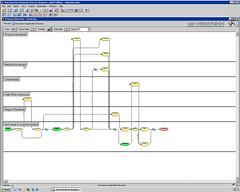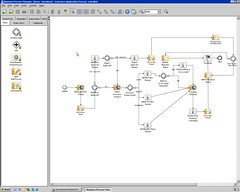I had a great experience at the Canadian passport office recently — words that are not often spoken in the same sentence — due to a bit of imaging and BPM technology that’s been possible for a long time, but is only just starting to be used in many industries.
My old passport was due to expire in July, and because many countries start to get antsy when your passport has less than six months to expiry, I decided to renew now while I had a 4-week window of no travel. I went online to Passport Canada and used the Passport Online application instead of downloading and filling out a PDF version on paper, and when I printed the final result, I noticed that it had a barcode embedded on each page of the form. I got all the necessary signatures and my photos, and headed for the passport office, taking along a book, my iPod, my Blackberry, a bottle of water, a snack and a fold-out bed. Okay, I’m kidding about the bed, but I was expecting a long wait — the downtown Toronto passport office is as crowded as an American Idol talent call.
The first step is triage: you wait in a relatively short line for someone to check over all your documents and make sure that you have everything and it’s all filled out properly, so that you don’t wait for an hour only to find out that you’re missing some vital bit. You wouldn’t think this would be necessary for responsible adults doing something as critical as getting a passport, but the person in front of me was missing half the information and had forgotten to have the guarantor sign the documents. You are then handed a number that puts you in the waiting queue for an available clerk to process your form, and I heard the triage clerk tell people that the wait was around an hour and a half.
I arrive at the triage desk, everything is in order, and the clerk says “you get a different number because you filled out the forms online” and hands me a numbered ticket prefaced with an “F”. I look up, and sure enough, there are “A” numbers, “B” numbers and “F” numbers on the call board. And I’m next in line in the “F” queue. Woohoo! Ten minutes later, I’m at the desk having my application processed, and less than two weeks later, my new passport is in my hands.
So what went on behind the scenes? I’m not privy to the internal workings of Passport Canada, but here’s my educated guess:
- I filled out the form online, and the data went directly into their passport application database. In other words, I did their data entry for them.
- They generated a unique application number, and printed that in barcode format on each page of the completed application that I printed to allow for automated matching with the data later in the process.
- After I submitted my form at the passport office, the paperwork was scanned and the barcode used to automatically match it with the data that I had entered previously — much faster and more accurate than attempting to perform OCR on the form data itself. The scanning likely kicked off a process in a BPM system, or caused it to rendezvous with an existing process that had been started by the online data entry step.
- At the next step in the process, someone viewed a scanned image of the sections of the document filled in by hand (my signature and that of my guarantor) and checked over all pages to make sure that I hadn’t made any hand annotations or changes.
- Some applications — either triggered by certain data on the application, input from the initial reviewer or just a percentage of the total volume — would have the references and guarantor information checked via telephone calls, so would be passed to a step in the process prompting someone to make those calls. I didn’t ask my references and guarantor if they had been called, but as a professional engineer I often am a guarantor on friends’ passport applications, and I am usually called by Passport Canada during the process.
- If all the data is verified and all the checks are passed, the application is approved, which would trigger the actual printing and mailing of the passport.
My reward for making their job easier was to get into a fast-track line at the passport office, which greatly reduced my wait time, and possibly a faster end-to-end time since I received the passport several days before I had expected. This reward is key, because it completely motivates me to do it again, and tell all my friends about it — although if everyone did this, then the fast line would have everyone in it and become the slow line.
This is similar to what some airlines are doing with online check-in: if you check in online and print your own boarding pass, then just have to drop off checked baggage, they provide a separate line just for those who checked in online. Of course, I showed up at the airport one morning expecting to have a short line for dropping off my bag, and it turned out that everyone used online check-in that morning, but it’s still a motivator.
This looks a bit like an old-fashioned imaging and workflow application, but it’s more than that: they’re integrating a web application, one or more back-end data systems, a content management system, some sort of BPM or workflow, and possibly even the passport production system itself. Furthermore, they’re changing their customer service model to motivate people to use this method, since it not only makes less work for Passport Canada, but it improves the speed of the process for the customer significantly. It’s not just about the technology, it’s about how you can use that technology to make your customers’ life easier, not just your own.
This sort of lesson seems to need re-learning every few years: if you automate a customer-facing business process to allow self-service, then you absolutely can’t make it more expensive or time-consuming for the customer, or you’ll have no one using it. If you actually make it cheaper or take less time than the non-automated service, like Passport Canada did, then you’ll have customers jumping on board faster than you ever dreamed possible.


